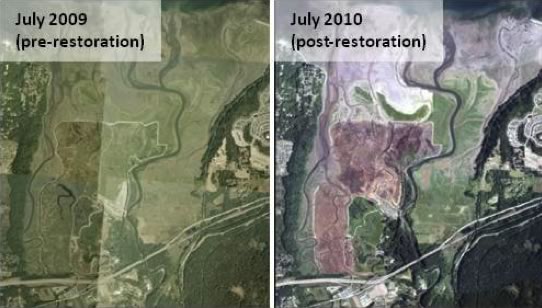Monitoring Design: Before-After Control-Impact
The overarching goal of the proposed monitoring plan is to assess status and trends of physical and biological responses to restoration actions. Thus, we propose a BACI (Before-After, Control-Impact) sampling framework (Stewart-Oaten 1986, Stewart-Oaten et al. 1992, Underwood 1992, Stewart-Oaten 2003) to structure the monitoring. The BACI concept is to examine the Before (pre-construction baseline) and After (post-construction) condition of the area, as well as to compare a Control (reference site) with the Impact site (restoration site). Before and After sampling will determine how the restoration process changed the site through time from its historical condition. Control and Impact sampling will allow effects of restoration actions to be discerned from natural variability, stochastic events, and underlying trends in the larger area – for example, sea level rise increasing water levels. A Control site which has identical conditions to the Impact site is not typically available. Thus, we use the term Reference site (see Smith et al. 1993) to describe areas near the restoration but not part of the area directly affected by the restoration project. The restoration and reference sites are typically monitored with similar intensity to allow for direct comparison of the different monitoring samples.

Aerial photograph pre- and post- dike removal, Nisqually estuary.
Baseline Data
Baseline data define the current condition of the community or population of interest and provide a basis with which to compare the responses of the system to future restoration actions. Baseline data collected at the restoration site and reference marsh provide a means to differentiate responses due to dike removal from natural stochastic variation.
Reference Marsh
Long-term data collected Before- and After- restoration actions and at a reference marsh are crucial to evaluating the restoration process and verifying predictive tidal marsh restoration models (Roman et al. 2002). A reference marsh serves as a model trajectory for the restoration site. Reference marshes should have a minimal history of anthropogenic disturbance and include the presence of desirable characteristics such as native plant communities, high species richness, presence of rare species, and valuable natural resource products (Zedler 2005).
